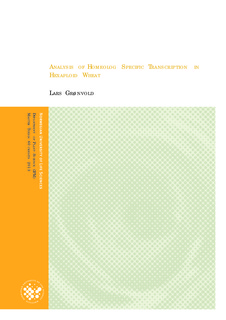| dc.description.abstract | Bread wheat (Triticum aestivum, BBAADD) is one of the most important food-crops world-wide. The genome of bread wheat is allohexaploid, meaning that it contains three related diploid genomes (termed A, B and D). This implies that most wheat genes exist in three similar copies (i.e. homeologs), which together with the fact that the genome mainly consists of repeats from transposable elements, makes the wheat genome very hard to sequence and assemble. Currently there is an effort by the International Wheat Genome Sequencing Consortium (IWGSC) to generate a wheat genome reference sequence. An enabling factor is the use of flow cytometry to isolate the individual chromosome arms which then can be sequenced and assembled separately. The final reference sequence is still a long way from being finished, however a short-read shot-gun sequence assembly of each chromosome arm, referred to as chromosome survey sequencing (CSS) assembly, has been made available from the IWGSC. Using the CSS assembly as reference for analyses of RNA-sequencing (RNA-seq) data enables us, for the first time, to distinguish and quantify the transcription level of the homeologous genes. In this study I use RNA-seq data sampled from the starchy endosperm, aleurone layer, and transfer cells of the developing wheat endosperm to analyze the homeolog-specific aspects of the hexaploid transcriptome. I found that three quarters of the genes have an expression bias towards either one of the sub-genomes, but that no sub-genome is favored on a general level. The pattern of homeolog bias shows no correlation with functional gene-groups, but 28% of the genes show developmentally controlled homeolog-specific regulation when comparing the sampled tissues. There is also evidence supporting that the D-genome has a different distribution of expression levels than A and B. This could be explained by the polyploidization history, or indicate the presence of hybridization in a D-genome ancestor. Greater understanding of the mechanisms that govern homeolog-specific gene regulation can have an impact on the way breeding of allopolyploids is performed. This study illustrates the importance of homeolog specific reference sequences, and the potential hexaploid wheat has as a model to study mechanism of gene-regulation in allopolyploids. | no_NO |
